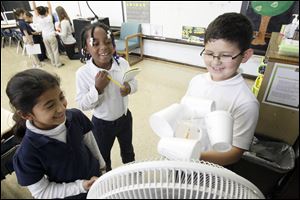
2nd-grade students delve into predicting weather
11/24/2012
Second graders Selena Garcia, left, and Heaven Williams, center, and Ruben Angel, right, use an anemometer and a fan to collect data so that they can predict weather for a lesson.
There are plenty of important reasons to know what kind of weather to expect.
“If it’s warm, I can play with my cousins and go to my friend’s house,” said Selena Garcia, a second-grader at Queen of Apostles School in Toledo.
“When it’s warm, I can play in the pool,” chimed-in classmate Miranda Ignat.
“It if snows, you can have a snowball fight,” suggested their classmate Isaiah Mercurio.
The second graders Brooke Bradley teaches at Queen of Apostles have been learning about weather since September. The effort is known as “Project-based Learning,” and involves a long-term project designed to develop deeper understanding of a topic, instead of a “shallow,” or “superficial” understanding, Ms. Bradley said.
At the semester’s beginning, students selected an overarching question they wanted answered. Ms. Bradley’s students’ question was, “How do we know what to wear outside tomorrow?”
Since September the students have built anemometers, wind turbines, windsocks, and rain gauges, and used them to evaluate weather patterns and make forecasts.
They’ve learned how to use infrared thermometers to record temperatures and designed and engineered their own weather vanes, which they used to record wind direction.
The information collected from their weather instruments and observations is recorded in a journal, said young Ignat. Ultimately the results will be used to create a digital report that will help students determine what to wear outside for the weather.
It’s not all a breeze. Sometimes the students encounter problems and have to figure out why their handmade weather instruments aren’t working. For example, some students weren’t having much luck with the weather vanes they made out of an empty cardboard tissue box and paper towel tube.
“It was hard,” 8-year-old Miranda said. “When we had to [test their weather vane] it wouldn’t spin all the way.”
Fortunately, their teacher and various weather experts were on hand to help. Guests this semester included Kevin Czajkowski, a scientist from the University of Toledo, and Geoff Cornish, a meteorologist for television station WTVG, Channel 13.
Many students were especially excited about viewing photos of, and asking the meteorologist questions about, tornadoes.
After explaining how tornadoes and other weather conditions are formed, Mr. Cornish quizzed students about where they should seek shelter during bad weather.
“We don't want you to be afraid of storms,” Mr. Cornish said. “We want you to understand them.”
Contact Federico Martinez at:
fmartinez@theblade.com
or 419-724-6154.